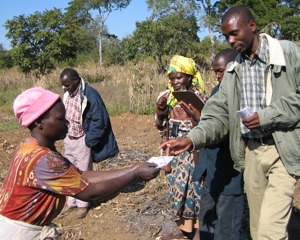Jessica Goldberg
Kwacha gonna do? Experimental Evidence about Labor Supply in Rural Malawi
current draft (Job Market Paper) (November 2010)
I estimate the wage elasticity of working in the day labor market in rural Malawi using panel data from a unique field experiment. One third of adults in rural areas in Malawi participate in the casual wage labor market, and the government recently invested $40 million in a public sector employment scheme. Creating day labor jobs is also a prominent policy tool for governments in other developing countries seeking to simultaneously reduce poverty and promote infrastructure development. Despite the importance of this sector to individuals and governments, the existing evidence about the elasticity of labor supply in developing countries is scarce and often poorly identified.
My estimates are from a field experiment in which 529 adults from ten different villages are offered a day's work once per week for 12 consecutive weeks. Each village faces a different wage each week; wages range from MK 30 ($US 0.21) to MK 140 ($US 1.00) per day. I observe whether or not each individual works at each wage. The experimental design provides exogenous variation in wages, allows me to observe the full distribution of wage offers rather than the censored distribution of accepted wages, and permits the inclusion of time and village or time and individual fixed effects. I estimate that the elasticity of employment is between 0.15 and 0.17, with no significant differences between men and women.
I use auxiliary data from a nationally representative survey to confirm that equal elasticities for men and women is typical of the Malawian labor market during the agricultural off-season, the time of year when my experiment takes place. I collapse my data into a censored cross section that mimics data used in the previous literature to demonstrate that my highly inelastic estimates are due to my improved identification strategy, rather than reflecting inherent differences between Malawi and other developing countries. My results reject backward-bending labor supply curves for men or women, and suggest that labor supply is highly inflexible along the relevant margin in poor, rural markets.
My estimates are from a field experiment in which 529 adults from ten different villages are offered a day's work once per week for 12 consecutive weeks. Each village faces a different wage each week; wages range from MK 30 ($US 0.21) to MK 140 ($US 1.00) per day. I observe whether or not each individual works at each wage. The experimental design provides exogenous variation in wages, allows me to observe the full distribution of wage offers rather than the censored distribution of accepted wages, and permits the inclusion of time and village or time and individual fixed effects. I estimate that the elasticity of employment is between 0.15 and 0.17, with no significant differences between men and women.
I use auxiliary data from a nationally representative survey to confirm that equal elasticities for men and women is typical of the Malawian labor market during the agricultural off-season, the time of year when my experiment takes place. I collapse my data into a censored cross section that mimics data used in the previous literature to demonstrate that my highly inelastic estimates are due to my improved identification strategy, rather than reflecting inherent differences between Malawi and other developing countries. My results reject backward-bending labor supply curves for men or women, and suggest that labor supply is highly inflexible along the relevant margin in poor, rural markets.
The Lesser of Two Evils: The Roles of Self-Interest and Impatience in Consumption Decisions
current draft (December 2010)
Individuals in poor agrarian economies sometimes exhibit high marginal propensities to consume that are
suggestive of high discount rates. I test whether informal insurance
networks or social norms about sharing income can explain the tendency to
spend income rapidly. The mechanism through which informal insurance networks
and social pressure may affect consumption and savings is through public
information about individuals' assets. To test the extent to which informal
insurance networks or the social norms that support them affect the timing
of consumption and level of savings, I employ a field experiment to distinguish
between the use of windfall money when receipt of the money is known to others
in the community versus when it is private information. I run two lotteries in
each of 158 agriculture clubs in central Malawi. In each club, one lottery and
its winner are publicly announced to the whole group. The other lottery is
private, and only its winner knows that a second lottery was held. I measure
differences in expected use of the windfall income between public and private
lottery winners. I find that public winners spend 35 percent more than private winners in the period
immediately following the lotteries. This spending pattern is consistent with a seven percent tax on surplus income in a simple model where a fraction of money that is not spent immediately must be shared with others in the social network.
Identification Strategy: A Field Experiment on Dynamic Incentives in Rural Credit Markets
(With Dean Yang and Xavier Gine) - current draft (September 2010)
How do borrowers respond to improvements in a lender’s ability to punish defaulters? We report the results of a randomized field experiment in rural Malawi that examines the impact of fingerprinting borrowers in a context where a unique identification system is absent. Fingerprinting allows the lender to more effectively use dynamic repayment incentives: withholding future loans from past defaulters while rewarding good borrowers with better loan terms. Consistent with a simple model of borrower heterogeneity and information asymmetries, fingerprinting led to substantially higher repayment rates for borrowers with the highest ex ante default risk, but had no effect for the rest of borrowers. The change in repayment rates is driven by reductions in adverse selection (smaller loan sizes) and lower moral hazard (e.g., less diversion of loan-financed fertilizer from its intended use on the cash crop).